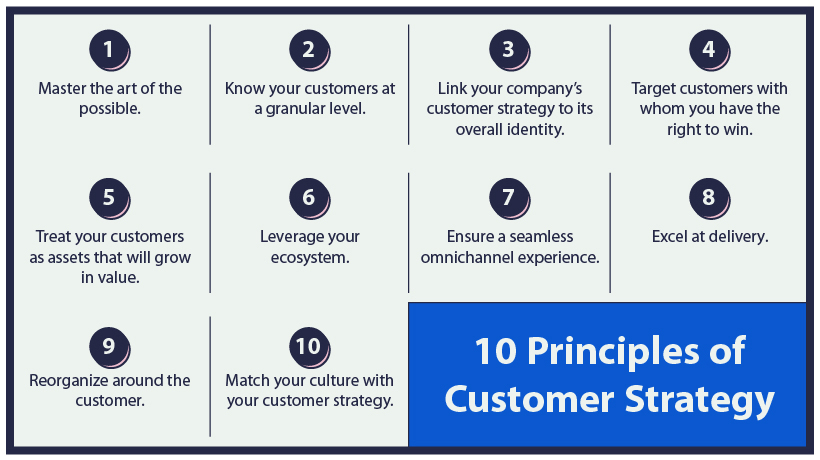Through the prism of the 10 Principles of Customer Strategy, this article examines the question of how to train remote employees in a virtual learning environment.
Training Your Employees Remotely
This article was drafted in July 2020, in the middle of what appears to be the second wave of the COVID-19 pandemic. The scale and impact of this event may never be fully appreciated, but from our view as learning and development professionals one thing is clear: for some time to come there will be limited in-person training, coaching and mentoring and more online, virtual, digital training, coaching and mentoring.
We are witness to the rise and falls of new tools, new training environments, new technologies. We are all searching for creative ways to convey the material previously delivered in front of class full of engaged (or not so engaged) employees. Nothing seems permanent right now but change. Rather than focusing on a specific tool that risks being obsolete within months or sharing a few nifty tricks, let’s take a more strategic look at how to train remote employees in a virtual learning environment.
Let’s imagine that our experienced employees, new employees, interns, and students are our customers, the implication being that we want them to like and enjoy our product, say nice things about our product, and truly benefit from our product. Taking it a step further, why don’t we also follow the modus operandi of most smart businesses, and invite our clients to help improve or perhaps even redesign our product?
In 2016 a team of researchers and advisors from the customer strategy practice at Strategy&, PwC’s strategy consulting group, conducted a global survey of 161 executives which resulted in the creation of the 10 Principles of Customer Strategy (read about the study here). According to the study:
A well-designed customer strategy will coordinate many different functions, skills and practices. For example, it should encompass data analytics; go-to-market and channel choices; and the delivery of products, services and experiences. Ten principles are at the heart of any effective customer strategy. These principles are universally applicable, regardless of what industry a company operates in, whether it focuses on a business or consumer clientele, where it does business, or what products and services it offers.
Now let’s bring our customers (learners) back into the equation. Through the prism of these ten principles, let’s examine the question of how to train remote employees in a virtual learning environment.

1. Master the Art of the Possible
From the learning and development perspective this point has a lot to do with your imagination. There are several components:
-
Technologies. What digital tools are available at your company? (Microsoft Teams? SharePoint?) Do you have a robust LMS? Are your training assets scattered somewhere on a public drive? Understand what you currently have and think about creative ways to use those technologies for seamless virtual delivery. Don’t focus on the lack of a particular tool or technology—with very few exceptions you can probably make it happen with what you’ve got.
-
Learning design. Once technologies are nailed down, put your creative skills to use to update the design of an already existing course, workshop, or learning program. Imagine the narrative. Put this into practice for all types of learning: virtual learning programs (a blended learning approach to a set of distinct, self-standing digital assets which synchronistic create a unique learning experience with specific goals and outcomes); one-time learning events such as virtual workshops; or perhaps freestanding eLearning modules. Identify the specific components of the learning experience and think about the tools and how you can use them to deliver and curate the learning. Things you should consider integrating into your learning design include:
-
- Deliver virtual instructor-led training (VILT) using meeting software such as Zoom.
- Share relevant resources or eLearning components through file-sharing sites such as SharePoint.
- Integrate elements of social learning, reinforcement, and discussion using any of the widely available social media platforms.
- Use free online tools to create quick surveys and polls.
- Allow participants to collaborate using virtual whiteboards.
- Self-awareness. As trainers, facilitators, teachers, we all have our personal style, built on our individual strengths. The key consideration here is to maintain those strengths despite the introduction of the virtual element. If you’ve previously relied on visual cues such as eye contact and “reading a room”, you’re going to have to pivot and discover new ways of creating and maintaining connection with your learners. Acknowledge your strengths and weaknesses, and take them into account. Allow yourself the freedom to explore creative ways of integrating your teaching style into a virtual environment.
2. Know Your Customers (Learners) at a Granular Level
This applies to any learning experience, be it in person or virtual. The distinction that comes into play for virtual learning is the knowledge of your target audience through the lens of the technology they use, the technology they like (and don’t like), and their online habits (the good and the bad). You can get as granular as designing learning assets for different age groups or skill levels. Knowing your learner will allow you to create a learning environment that will not only serve as a library of learning assets, but can also evolve into a vibrant virtual learning ecosystem.
- Email a survey to a test group or a department in your company. Get a sense of their digital habits and preferences *before* you embark on creating virtual learning assets or entire programs.
- At a very basic level, gain awareness of your learners’ learning styles as this also can inform the design and execution of the virtual learning experience.
3. Link Your Company’s Customer Strategy to Its Overall Identity
Translation: Link your company’s identity and strategy to your learning efforts. Conveying the critical drivers is all too often overlooked. Why is this training important? What’s at stake? What’s in it for the learner? What’s in it for the team, the department, the company? What are the business and safety rationales? If expressed openly and confidently, the answers to these questions can shift learners’ attitudes from apathetic to engaged.
Create a short learning video (example) or presentation which explains the rationale behind the learning effort. Always consider the impact on and potential benefits for the learner. Be honest and up front.
4. Target Customers With Whom You Have the Right to Win
Right about now you’re probably thinking that you don’t have much choice when it comes to targeting who to train. While that may be true, you can take Principle #2 (Know Your Learners at a Granular Level) a step further so as to target your audience based on experience, proficiency, skill levels, or comfort levels with a medium or technology. The power of targeting the right learner with the right virtual learning asset is that you will likely reduce the amount of training necessary hence creating a more enjoyable, applicable, and practical learning experience. For example, advanced learners can skip the fundamental levels of a training program, but can refer to it for information and reference if desired.
Creating a robust and granular virtual learning curriculum has the additional advantage of blurring the boundary between training and performance support. Fragmenting the training into “bite sized” microlearnings which can be consumed not only during the training but also after the training at the point of need gives you a two-for-one that can only benefit your learners.
When you design a learning program or an individual learning event (web-based training, learning video, workshop) always think of the learning bottom line: What is it that my learner needs to walk away with in order for this training to be successful? If you’re teaching a process, ask this question after each step; if you’re teaching a concept, ask this question after each element. Create a digital quick reference guide for future reinforcement or as performance support.
5. Treat Your Customers (Learners) as Assets That Will Grow in Value
Any talented human resources professional would agree with this statement. Organizations obviously expect new hires to grow and improve. Corporate learning, education, and development are the tools through which this process is enhanced, accelerated, and facilitated. However, if the quality of most corporate learning is any indication, organizations don’t always view their learners as assets with potential.
Operating on the assumption that the more you value something, the better you treat it, and then applying that assumption to corporate learning, this principle is often sorely neglected. Look critically at the quality, quantity, design, distribution and delivery of your current learning portfolio. Could it be improved? Could it be made more fun? Could it become more social? Factor in the additional feelings of isolation that the current pandemic might have generated. Learning and HR professionals must pay heightened attention to the careful design, creation, and delivery of all virtual learning deliverables to take these considerations into account.
6. Leverage Your Ecosystem
This point is closely related to Principle #1 (Master the art of the possible.), specifically the technology aspect. Your learners, particularly the seasoned employees, are set in their ways. They know how they receive information about the training they need to attend. They know where to log in. They know what to expect from a two-hour-long web-based training at your organization. They know whether they’ll be asked if they enjoyed the learning experience. They are aware of the follow-up and potential reinforcement activities. Build on this knowledge and awareness, don’t fundamentally change it. Use the currently existing technology and be creative.
7. Ensure a Seamless Omnichannel Experience
Despite all appearances, this is not in contradiction with Principle #6. Most (if not all) of the tools and technologies you’re currently using to create, facilitate, or distribute your virtual learning programs, assets, or deliverables have a mobile component. The focus here is on design and execution, rather than technology. If your target audience requires on the job learning support (microlearnings, infographics, electronic checklists…) it needs to be designed and created for mobile delivery.
This applies to contemporary adult learning and development in general. Adults read less and less, and currently up to 70% of learners are visual learners (which explains the popularity of learning videos). Creating visually heavy and text light learning (slides, infographics, animations, videos, documents, checklists…) is no longer simply good practice—it’s necessity. Use graphs, charts, photographs, videos, and animations. Structure slides into infographics which will facilitate robust discussion. Provide details via digital reference documents.
8. Excel at Delivery
This principle doesn’t require much clarification, but from our perspective there are three components of perceived excellent delivery:
- Technology and connection speed. With virtual learning programs, particularly live workshops, this point depends not only on the technology provided by your organization but also the bandwidth of the participants. Delivery speeds can vary, widely especially if you’re targeting a multinational audience. In some countries video and animation streaming is simply not practical, and training might be limited to the audio component. This should be a key consideration for all eLearning materials.
- Ease of user experience. Consider that with most virtual learning programs, there may be no facilitator or trainer to answer questions from the audience. User-friendliness, intuitive layout, and clear rules and expectations are imperative when it comes to excellent delivery. The frustration that comes with not knowing where to go, what to do, and what to do next can sour the most elaborate virtual learning experience.
- Narrative. Provide you virtual audience with a sense of story or adventure. Explain why they are being asked to do what they are being asked to do. Seek and allow for constant feedback; communicate and respond. Show the learner how each component of your workshop, eLearning course, or full blown virtual learning program work together and how they can best benefit from each element.
9. Reorganize Around the Customer (Learner)
We began with the suggestion that you should use existing infrastructure, technologies, and learning assets, and that there is no need to run out and buy the latest piece of collaborative technology. While true, this doesn’t mean that you can neglect to seek feedback from your target audience and act upon it. Listen and learn from your learners. Provide channels for a frank, constructive feedback loop. Involve management; show them the impact of their decisions (or lack thereof). Make the learner the centerpiece—make the learner the customer.
Invite your supervisor or someone from operations (in a related field) to your virtual learning class or ask them to play in the sandbox of your virtual learning program. They will be able to help you identify the weak points and improve the efficiency of the learning experience.
10. Match Your Culture With Your Customer (Digital Learning) Strategy
Do you or your coworkers miss the quarterly workshops, regular town halls, or annual learning conferences? Are employees fed up with spotty Wi-Fi or constant freezing of screens during your training?
Believe me, we feel your pain. But the reality is that in-person gatherings may not be possible for quite some time, and there’s not much you can do about the Wi-Fi. The point is that prolonged disconnect, if left untended, can influence the learning and even the corporate culture of your organization. Take that into account. Involve your learners and employees. Create an outlet not only for frustrations but also for celebrations—as much or as little as it suits the culture of your organization.
Organize a learning happy hour. Offer a casual (virtual) meeting environment for your department or team to talk about their learning needs, gather feedback on your current efforts, or just collect ideas for improvement. This can also be done through social media or the use of channels in online management tools or in an LMS. If possible (and culturally feasible) motivate participants through competition, games, or rewards.
Obsidian Learning has been creating virtual learning deliverables for over 20 years, and though not articulated as such, has been integrating the principles outlined here in all aspects of our work. Applying the 10 Principles of Customer Strategy will help you create effective virtual programs to support your employees in the most valuable and relevant way possible—by sharing the information they need to make them, you, and your organization successful in times when in-person education just isn’t an option







